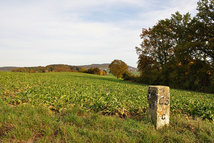Border: Germany-Switzerland
Date(s) of establishment: 1815 (Congress of Vienna)Length of border: 334 km
Regions concerned: Germany – Baden-Württemberg; Switzerland – Cantons of Basel-Stadt, Basel-Landschaft, Aargau, Zurich, Schaffhausen, Thurgau
European programme(s):
- Interreg IV A – "Upper Rhine"
Website of the programme
The programme on the Inforegio website - Interreg IV A – "Alpenrhein - Bodensee - Hochrhein"
The programme on the Inforegio website
At a length of 334 km, the German-Swiss border meanders from east to west. It begins at the tripoint with the Franco-German and Franco-Swiss borders on the Rhine. It then follows the course of the Rhine, through the middle of Lake Constance and ends at the tripoint formed with the German-Austrian and Austro-Swiss borders also located on the lake. A peculiarity of the German-Swiss border is the German enclave of the municipality of Büsingen, bordered on the right bank in the canton of Schaffhausen and on the left bank by the cantons of Thurgau and Zurich.
History:
In 1815 at the Congress of Vienna, the European powers recognized the neutrality of Switzerland as well as its internal and external borders, largely those of today. Switzerland having maintained its neutrality during World War II, the German-Swiss border did not undergo changes related to the war, which differentiates it from other German borders.
Cross-border cooperation:
Switzerland is not part of the European Union, which changes the situation somewhat in matters of cross-border cooperation. Despite this it has cooperated for many years intensively with Germany, especially in the territory of the Upper Rhine, which brings together the Alsace region in France, the cantons of Basel-Landschaft, Basel-Stadt, Aargau, Jura and Solothurn in Switzerland and the Länder of Baden-Württemberg and Rhineland-Palatinate in Germany; and the territory of the International Lake Constance Conference (International Bodenseekonferenz) that bring together the German Länder of Bavaria and Baden-Württemberg, the Swiss Cantons of Schaffhausen, St. Gallen, Thurgau, Zurich, Appenzell Ausserrhoden and Appenzell Innerrhoden and the Austrian Land of Vorarlberg and the Principality of Liechtenstein.
The German-Swiss border is covered by two operational programmes. The western portion of the border participates in the "Upper Rhine” operational programme, which funds projects in the fields of economic development, education and training, employment, culture and public services, and sustainable development. In addition to individual projects, the programme also supports four microproject funds. Eastern Switzerland is also involved in the tri-national cross-border programme "Alpenrhein - Bodensee - Hochrhein". It concerns a privileged area whose GDP is several times higher than the European average. The region intends to use its economic potential to be at the forefront of innovation and improve its competitiveness. In order to achieve this, the programme promotes advanced networking and close cooperation between labour markets.
The entry of Switzerland into the Schengen area in 2008 represents an important step forward for cooperation. Although customs controls for goods remain in force, cross-border relations between Switzerland and Germany have developed considerably in recent years.
Given the closeness of relations, many institutional arrangements have been established to formalise and structure cross-border cooperation, both at the level of the International Lake Constance Conference (Internationale Bodenseekonferenz) and the Upper Rhine territory. Examples at the local level include: Trinational Eurodistrict Basel (ETB), the Network of Cities of the Upper Rhine, the RegioTriRhena and the Euregio Bodensee. At the regional level within the territory of the Upper Rhine, the Upper Rhine Conference, created in October 1975, has set up a "Franco-Germano-Swiss Intergovernmental Commission" designed to address the problems common to the three countries in order to provide joint solutions. This project, championning cross-border cooperation, is not the only one to bring together Germany and Switzerland, as the "Trinational Metropolitan Region of the Upper Rhine" was born in October 2010. This arrangement provides a framework for enhanced cooperation between public- and private-sector stakeholders, centres of expertise and resources, businesses, and more generally the whole of civil society. Also present within the Upper Rhine territory are the Upper Rhine Council (Conseil Rhénan) and the Tripartite Congress.
Photo : Dörflingen - Copyright : Simisa
Territory projects and institutional bodies for cooperation
Institutional cooperation at the state level
Franco-Germano-Swiss Intergovernmental CommissionCross-border cooperation at the regional level
Tri-national Metropolitan Region of the Upper RhineUpper Rhine Conference
Upper Rhine Council
Network of Cities of the Upper Rhine
Arge Alp
Communauté de travail Alpe-Adria
Cross-border cooperation at the local level
Konstanz-KreuzlingenBasel Trinational Eurodistrict


